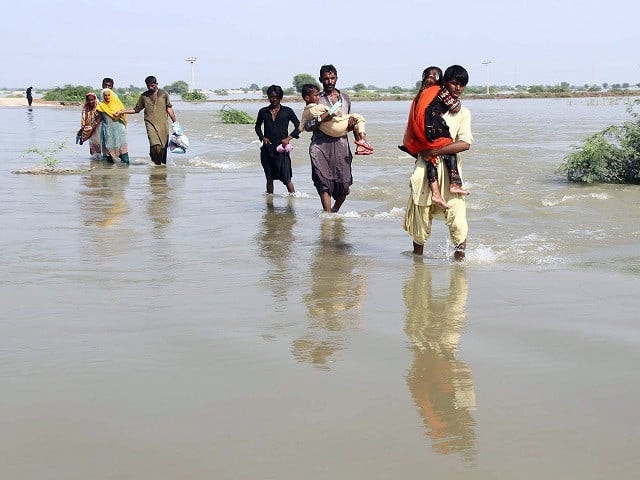Planning Commission puts flood damages at $28b
Inflationary pressures expected to further 'aggravate', economic growth rate likely to slow down, predicts report

The Planning Commission of Pakistan has estimated the cost of flood damages and losses at $28 billion — the fourth figure pitched by any Pakistani authority since devastating floods, as it also sees the reconstruction period spanning over 10 long years.
The $28 billion cost includes the $11 billion losses on account of slower than the targeted growth rate of 5% — a figure that could be challenged by the international lenders who were predicting a 3.5% growth rate even in pre-flood scenario.
The Planning Commission shared its post-flood economic outlook and damage need assessment synopsis on Monday.
This came at a time when a comprehensive post-damage and need assessment are underway in collaboration with the international financial institutions, European Union (EU) and the United Nations (UN).
The initial estimates were shared with experts with a motive to seek their input for crafting a way forward.
Some initial estimates are indicating the extent of damage is to the tune of $28 billion”, according to the findings presented in the meeting. Earlier, the Ministry of Finance first gave $10 billion to $12 billion initial estimates and then revised the figure to $18 billion. Subsequently, the National Flood Response Coordination Centre pitched the $40 billion number.
The report shows that the inflationary pressures “are expected to further aggravate” and the economic growth rate is expected to slow down to 1.8% to 2.3%.
The development took place the day the Pakistan Muslim League-Nawaz has brought back its financial wizard Senator-elect Ishaq Dar to steer the country out of economic crisis, particularly for restoring the value of the rupee that recovered by Rs3 to a dollar on the news of Dar’s return.
The report showed that inflationary pressures are expected to further aggravate due to supply chain disruptions and shortage of perishable items.
As against the average inflation target of 11.5%, the inflation is expected to remain between 23-25%, according to the Planning Commission —a figure that is lower than the World Bank estimates, which sees inflation crossing the 27% rate in this fiscal year.
The Planning Commission said that the Gross Domestic Product growth rate for the current fiscal year is estimated at 1.8 – 2.3% compared to the Annual Plan target of 5%. This translates into an income loss of Rs2.4 trillion, it added.
The WB has given 1.4% to 2.4% GDP growth figures for this fiscal year, and the Planning Commission’s estimates are in line with the Washington-based lender’s assessment.
Out of the $28 billion, the Planning Commission has estimated that the losses sustained by the provincial governments amounted to $10 billion. Punjab took $550 million hit, Sindh $5.9 billion –the worst affected unit, Khyber Pakhtunkhwa $540 million and Balochistan $3 billion –the second most affected province.
The Ministry of Railways has estimated $2.4 billion losses to its infrastructure, followed by $290 million losses estimated by the Ministry of Water Resources and $210 million by the National Highway Authority.
In addition to that, the cost of economic losses is estimated at $11 billion, according to the Planning Commission.
The government has estimated that it will need $4 billion under the Flood Protection Plan-IV of 2017 for building protection walls and installing early warning systems and advance metering. Interestingly, the Planning Commission documents showed that in May 2017, the CCI approved “the final draft version of NFPP-IV costing Rs332.2 billion” or $1.4 billion at today’s rate.
But “the umbrella PC-I of NFPP-IV could not be approved due to financial constraints”, revealed the documents.
The Planning Commission estimates a loss of 1.8 to 2 million jobs. On average poverty may increase by 4.5 to 5%, implying that 9 to 12 million people will fall below poverty line, according to the Planning Commission –a figure that is lower by 3.5 million than the estimate of the World Bank.
The Planning Commission has estimated the export losses at $3 billion during the current fiscal year due to a decline in global demand and lower exports of rice, cotton, fruits and vegetables. Imports of raw cotton, wheat, and vegetables are expected to increase due to flood losses. Water availability is expected to improve the energy mix, resulting in lower oil imports, it added.
Agriculture
The report showed that major crops like cotton, rice, maize, and sugarcane are largely affected by the flood while the growth in major crops is expected to remain negative by 14 % to 15.4%. The growth in other crops is expected to remain negative by 12 to 15%.
Around one million large and small animals have perished. The anticipated growth of 3.7% in livestock is now expected to remain between 2 to 3%. Loss in growth of the agriculture sector is expected to be 3.5 to 4.5%. As a result, agriculture growth may remain negative by 0.7 to 2.1% compared to the target of 3.9%.
Industry
The loss in the growth of the industrial sector will be 3.5% to 4% due to its backward linkages with the agriculture sector, according to the report. Lower availability of domestic cotton and high global prices will lead to a drop in the growth of the textile sector. Due to lower demand, automobiles and fertilizer sectors are also expected to be affected. Industry growth for FY 2023 is expected to be 1.9 to 2.5% compared to the target of 5.9%, according to the Commission.
Services
Wholesale and retail trade services will be adversely affected and its growth will remain at 3% compared to the target of 6.5%, according to the report. The transport & storage services are expected to grow by 3% compared to the target of 4.5% due to damages of crops, livestock, roads and rail networks.
Hoteling & tourism and Education services are also expected to suffer. Services growth for FY 2023 is now expected to be 3-3.5% compared to the original target of 5.1%.
The immediate challenge is the early recovery of the flood-affected people as the agriculture sector has been affected badly which will have a negative impact on our economy and needs to be addressed immediately, said Ahsan Iqbal, the Planning Minister, who chaired the session.
The action-oriented plan to rebuild, and restructure the affected areas of the country in which short and long-term plans will be executed between six- months to 10 years, according to Iqbal. The rescue and relief period is estimated at one month to two months while the rehabilitation may take two to six months, according to the report.
The reconstruction period is estimated in the range of two to 10 years.
Dr Adnan Rafiq, Member Governance, Planning Commission suggested that the owner driven reconstruction approach should be adopted with effective mechanisms to ensure compliance with the building codes developed by the government.
He also argued that vulnerable groups should be prioritised in the rehabilitation process which includes women and youth.



















COMMENTS
Comments are moderated and generally will be posted if they are on-topic and not abusive.
For more information, please see our Comments FAQ